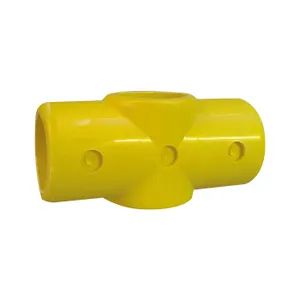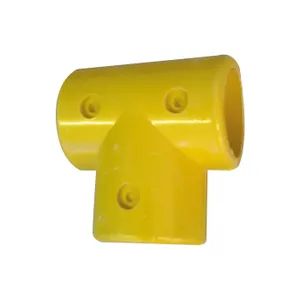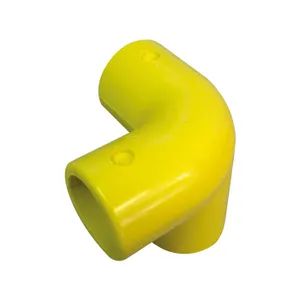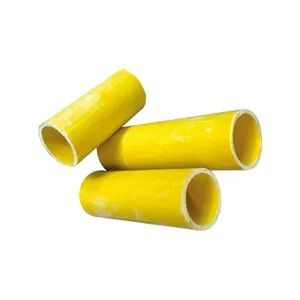Il nostro sistema di corrimano in PRFV è spesso utilizzato in corrimano o guardrail in PRFV per continuare il binario centrale su un angolo di 90° o collegare i montanti verticali al binario superiore o per unire il binario intermedio al montante terminale.
Introduzione alle prestazioni del prodotto
|
|
Il raccordo girevole esterno in GRP è un raccordo girevole in linea versatile, spesso utilizzato dove gli angoli variano su pendenze, gradini e pianerottoli. |
|
Il GRP 116 Mid Corner è un giunto angolare a 90°, spesso utilizzato in un corrimano o guardrail in PRFV per continuare il binario centrale su un angolo a 90°, ma può anche essere utilizzato per costruire strutture rettangolari o quadrate. Il montante passa verticalmente attraverso il raccordo in PRFV. Spesso utilizzato con l'angolo superiore GRP-128. |
|
|
Il T corto GRP 101 è un collegamento a T a 90°, generalmente utilizzato in un corrimano in GRP per collegare i montanti verticali al binario superiore o per unire il binario intermedio al montante terminale. Il tubo non può essere unito all'interno della parte superiore del raccordo: in alternativa è possibile utilizzare il T lungo GRP-104, se necessario. |
|
Il raccordo trasversale in PRFV 119 è un giunto a 90°, spesso utilizzato per unire il binario centrale a un montante intermedio in un corrimano o guardrail in PRFV. Il montante passa verticalmente attraverso il raccordo in PRFV. |
|
|
Il T lungo GRP 104 è un collegamento a T a 90°, generalmente utilizzato per collegare i montanti verticali al binario superiore di un corrimano in PRFV. Il GRP -104 può essere utilizzato quando è necessario unire due tratti di tubo all'interno della parte superiore del raccordo. |
|
Il raccordo GRP 125 è un gomito a 90°, spesso utilizzato in un corrimano o guardrail in GRP per collegare il binario superiore al montante verticale alla fine di una corsa. |
|
|
Il GRP 129 è un raccordo a T da 30°, spesso utilizzato nel corrimano o nel guardrail in PRFV delle scale. |
|
Il raccordo 128 Top Corner è a 3 vie. Gomito a 90°, tipicamente utilizzato per unire un montante verticale al binario superiore di un corrimano in PRFV su un angolo di 90°. Spesso utilizzato con il GRP-116 Mid Corner. |
|
|
Il GRP 130 è una croce a 30°, spesso utilizzata per collegare la ringhiera ai montanti intermedi nel corrimano in PRFV di una scala. |
|
Il GRP 116 Mid Corner è un giunto angolare a 90°, spesso utilizzato in un corrimano o guardrail in PRFV per continuare il binario centrale su un angolo a 90°, ma può anche essere utilizzato per costruire strutture rettangolari o quadrate. Il montante passa verticalmente attraverso il raccordo in PRFV. Spesso utilizzato con l'angolo superiore GRP-128. |
|
|
La piastra di base GRP 132 è una flangia di base con quattro fori di fissaggio, utilizzata per fissare i montanti in un corrimano o guardrail. |
|
Il GRP 173 Single Swivel è un raccordo girevole versatile, utilizzato dove gli angoli variano su pendenze, gradini e pianerottoli. |
|
|
La presa a muro 145 è un raccordo in PRFV progettato per il fissaggio laterale di corrimano o guardrail in PRFV a pareti, rampe e gradini. | 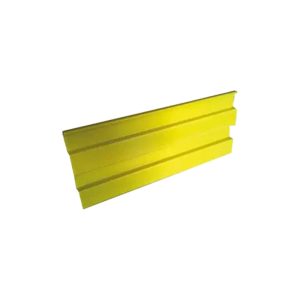 |
La nostra piastra kick in GRP è larga 100 mm, con una parete di 5 mm. È disponibile in lunghezze di 6 m, ma può essere tagliato su misura se necessario. |
Realizzato in plastica rinforzata con vetro (GRP) in Cina, il sistema di corrimano in PRFV di TFcomposite offre vantaggi chiave rispetto all'acciaio che spiegano perché vedrai i corrimano in PRFV ovunque, dai lavori di trattamento delle acque al settore ferroviario.
Fiberglass Reinforced Plastic (FRP) handrail systems are advanced, durable solutions for safety and access in industrial, commercial, and architectural applications. They are valued for their strength, corrosion resistance, and low maintenance, making them ideal for environments where traditional materials like steel or wood might fail due to exposure to harsh elements. Below is an in-depth exploration of FRP handrail systems, their components, benefits, applications, installation processes, and maintenance.
1. What is an FRP Handrail System?
An FRP handrail system is a modular or pre-engineered safety barrier system made from fiberglass reinforced plastic, a composite material that combines strong fibers with a polymer matrix. This results in a product that is lightweight, strong, and resistant to corrosion, chemicals, and UV exposure.
Key Components
FRP handrail systems typically consist of:
- Rails: The horizontal components providing continuous support.
- Posts: Vertical elements anchored to the ground or structure to support the rails.
- Knee Rails: Secondary horizontal rails for additional support and safety.
- Toe Boards: Base-level components to prevent tools or debris from falling.
- Raccordi: Connectors, brackets, and fasteners that hold the system together.
- Bases and Mounts: Used to anchor the system to floors, walls, or other surfaces.
2. Materials and Manufacturing
FRP handrail systems are produced using two main manufacturing methods:
- Pultrusion:
- Continuous fibers are pulled through a resin bath and a heated die.
- Ensures uniform strength and a smooth finish.
- Modanatura:
- Fiberglass mats or woven roving are layered and infused with resin in a mold.
- Often used for complex or custom shapes.
Common Materials in FRP Handrails
- Fibers: Typically glass fibers for high tensile strength.
- Tipi di resina:
- Poliestere: Cost-effective and moderately resistant to chemicals.
- Vinilestere: Higher resistance to chemicals and heat.
- Epoxy: Superior mechanical strength and adhesion.
Additives like UV inhibitors, fire retardants, and pigments can be incorporated to enhance performance and aesthetics.
3. Key Benefits of FRP Handrail Systems
FRP handrail systems offer several advantages over traditional materials:
3.1. Corrosion Resistance
- Ideal for environments exposed to chemicals, saltwater, or moisture.
- Used in wastewater plants, marine applications, and chemical processing facilities.
3.2. Lightweight and Easy Installation
- Weighs significantly less than steel or aluminum, reducing transportation and labor costs.
- Modular designs often allow for easy assembly without specialized tools.
3.3. High Strength-to-Weight Ratio
- Provides comparable or superior strength to traditional materials with less bulk.
3.4. Durability and Longevity
- Resists cracking, warping, and degradation over time.
- Long service life even in extreme conditions.
3.5. Low Maintenance
- Requires no painting or frequent inspections.
- Resistant to rust and biological growth.
3.6. Electrical and Thermal Insulation
- Non-conductive, making it safe for electrical environments.
- Low thermal conductivity reduces the risk of burns in high-temperature areas.
3.7. Customizability
- Available in various colors, sizes, and configurations to suit specific requirements.
- Aesthetic options enhance compatibility with architectural designs.
4. Applications of FRP Handrail Systems
FRP handrails are used across diverse industries due to their adaptability and robust properties. Below are examples of key application areas:
4.1. Industrial Facilities
- Impianti chimici: Withstand chemical splashes and fumes.
- Oil and Gas: Non-corrosive properties ensure longevity in offshore and onshore facilities.
- Centrali elettriche: Non-conductive properties provide safety in electrical substations.
4.2. Water and Wastewater Treatment Plants
- Resistant to chlorine, acids, and moisture.
- Ideal for walkways, platforms, and tank access.
4.3. Marine and Coastal Environments
- Unaffected by saltwater corrosion.
- Used on docks, piers, and offshore platforms.
4.4. Public Infrastructure
- Bridges, parks, and pedestrian walkways where safety and aesthetics are essential.
4.5. Commercial and Residential
- Balconies, staircases, and ramps requiring modern, low-maintenance railings.
5. Design Standards and Compliance
FRP handrail systems are often designed to meet rigorous safety and engineering standards, including:
-
OSHA (Occupational Safety and Health Administration):
- Ensures compliance with workplace safety guidelines for handrails.
- Requires specific height, strength, and deflection properties.
-
ASTM (American Society for Testing and Materials):
- Provides testing standards for strength, durability, and material performance.
-
ISO (International Organization for Standardization):
- Covers quality and environmental safety standards globally.
-
ADA (Americans with Disabilities Act):
- Mandates handrail accessibility features, such as smooth surfaces and appropriate height.
6. Installation of FRP Handrail Systems
Installing an FRP handrail system involves the following steps:
6.1. Preparation
- Assess site conditions and ensure the surface is clean and level.
- Mark installation points based on a pre-approved layout or engineering design.
6.2. Assembly
- Install base mounts or brackets at marked points.
- Attach posts to the base mounts using bolts or adhesives.
- Secure horizontal rails and knee rails to the posts using brackets and fasteners.
- Attach toe boards if required.
6.3. Finishing
- Tighten all connections and inspect for alignment.
- Apply sealants or coatings if additional protection is needed.
6.4. Safety Testing
- Perform load tests to ensure compliance with safety standards.
- Inspect for any loose connections or misalignments.
7. Maintenance of FRP Handrail Systems
FRP systems require minimal upkeep, but periodic checks can ensure maximum performance:
7.1. Cleaning
- Use mild soap and water to remove dirt, debris, or grease.
- Avoid abrasive materials to prevent surface scratching.
7.2. Inspection
- Check for loose fittings, bolts, or cracks in the material.
- Inspect joints and connections regularly.
7.3. Repairs
- Damaged components can often be replaced individually without dismantling the entire system.
- Use compatible adhesives or replacement parts from the manufacturer.
8. Customization Options
FRP handrail systems are highly customizable, allowing for adaptation to specific needs:
- Colors: Yellow, green, grey, or custom colors for branding or safety coding.
- Dimensioni: Varying rail diameters and post heights to meet specific requirements.
- Surface Finishes:
- Smooth for aesthetic purposes.
- Textured for slip resistance.
9. Cost Considerations
While the initial cost of FRP handrails may be higher than traditional materials, their long-term cost-effectiveness makes them an attractive option. Key cost factors include:
- Material grade (polyester vs. vinyl ester).
- Customization requirements.
- Installation complexity.
- Quantity and scale of the project.
10. FRP Handrail System vs. Traditional Materials
| Caratteristica | FRP Handrails | Steel Handrails | Aluminum Handrails |
|---|---|---|---|
| Resistenza alla corrosione | Eccellente | Povero | Moderare |
| Peso | Leggero | Heavy | Leggero |
| Maintenance | Basso | Alto | Moderare |
| Forza | Alto | Molto alto | Moderare |
| Conduttività elettrica | Non-conductive | Conductive | Conductive |
| Cost (Initial) | Moderate to High | Low to Moderate | Alto |
| Cost (Lifetime) | Basso | Alto | Moderare |
11. Future Trends
- Enhanced Aesthetics: New pigments and coatings for modern designs.
- Sostenibilità: Use of recycled or eco-friendly resins.
- Smart Systems: Integration of IoT sensors for safety monitoring.
Conclusione
FRP handrail systems are a superior choice for industries and environments requiring durability, safety, and low maintenance. Their adaptability and performance advantages over traditional materials make them a long-term investment for infrastructure and industrial facilities. By leveraging their modular design, ease of installation, and customization capabilities, FRP handrails continue to gain prominence in diverse applications.
Detailed Overview of FRP Handrail Systems
Serie:
Prodotti principali >applicazione
Il nostro sistema di corrimano in PRFV è ampiamente utilizzato nei corrimano in PRFV e nella connessione incrociata multi-drop-and-continue del guardrail.
Marchio :
TFcomposito
Colore :
giallo o grigio
FAQ
Q :
Di quali dimensioni e lunghezza è disponibile il tubo del corrimano in PRFV?
UN :
Il tubo in PRFV è prodotto solo con diametro esterno di 50 mm ed è disponibile a magazzino in lunghezze di 5 m. Se necessario, possiamo tagliare il tubo a misura.
Q :
Come vengono fissati i raccordi al tubo?
UN :
I raccordi per corrimano in PRFV vengono forniti come due metà identiche che si fissano semplicemente insieme attorno al tubo. Questi devono essere forati in loco utilizzando una punta da trapano HSS standard da 9 mm di diametro (fornita con l'ordine) e imbullonati insieme agli speciali fissaggi rivetti in acciaio inossidabile forniti. I bulloni vengono quindi inseriti e serrati utilizzando un cacciavite Pozi 3, il fissaggio del dado zigrinato rimarrà in posizione mentre il bullone viene serrato. Questi fissaggi forniscono una finitura a filo senza teste dei bulloni sporgenti.
Q :
Quali colori sono disponibili per i sistemi di corrimano in PRFV?
UN :
Disponiamo di tubi e raccordi in giallo – per alta visibilità – o grigio.
Altri prodotti correlati








